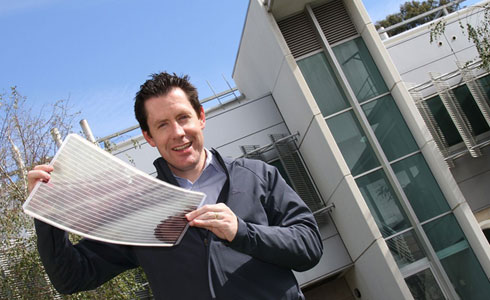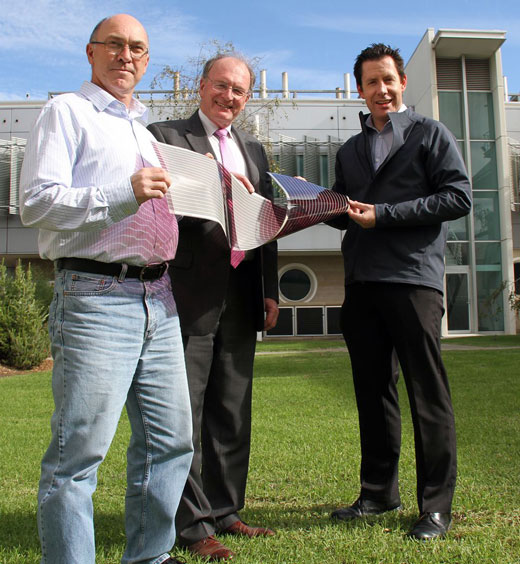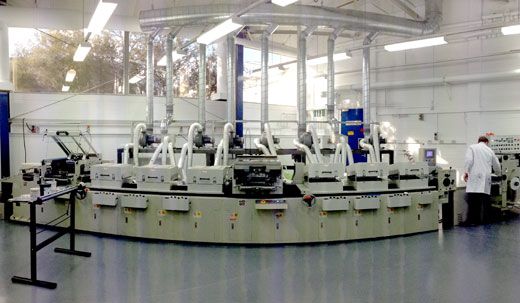Printed solar cells as easy to produce as t-shirts!

Australia is really taking the initiative in alternative energy production. The latest news is that a consortium of Australian researchers have succeeded in producing printable solar cells, in a process which might just have the potential to revolutionise solar power production across the continent. Perhaps, we can only hope, the world.
Succinctly, a new printer which has been installed at CSIRO is capable of printing solar cells the size of A3 sheets of paper – the largest ever created. Printing onto sheets of flexible plastic, it can produce these at a rate of 10 metres per minute (one new and fully functioning solar cell every 2 seconds!), and those cells can produce between 10-50 Watts per square metre, dependent upon how much light they receive. Oh, and the best part? The printer uses no brand new or special technology. In fact, it’s not a lot different to mass producing printed t-shirts!
The group responsible refer to themselves as the Victorian Organic Solar Cell Consortium (VICOSC), and they’re made up of a collaboration between CSIRO, The University of Melbourne, and Monash University, together with a handful of industry partners. Over the past 3 years, they’ve been working on printing solar panels. Starting with a cell the size of a human thumbnail, they’ve scaled their way up to larger and larger sizes. And they have plans. Big plans.

I mentioned a little while ago in my article about wind power, that I’m a keen advocate of alternative energy. This is because, and let’s be frank here, energy based on crude oil is not sustainable in the long term. I could list dozens of reasons why this is the case, not least of which is the fact that oil reserves are limited. But the biggest factor is pollution. We really need to start taking better care of this world.
Australia, it has to be said, receives one thing in abundance. Sunlight. Developing solar power seems like something of a no brainer, especially for more isolated areas. In fact though, the Earth receives a staggering amount of solar energy constantly.
Sunlight hitting Earth carries with it approximately 174 petawatts (174,000,000,000,000,000 watts!) of power. Of course, for the most part we’ll never be able to harvest it. Around 30% is immediately reflected back into space (which is good, because otherwise our planet would boil). But if we could harvest just 0.01% of the solar energy hitting our planet, we would have more power than the entirety of human civilisation can currently use!
Realistically, powering everything on our world with solar power may not be feasible. But a significant fraction of global energy needs could be easily met with solar power – particularly in areas which receive a lot of sunlight. Areas like much of Australia. The new techniques developed by VICOSC could make solar energy much more accessible to the world at large.
Firstly, the printing techniques they use are familiar to us all. Essentially, it’s much the same as screen printing – except that they use semiconductive inks which can be printed onto either flexible plastic or steel, dependent on where precisely they’re needed. Even better, the group are currently researching new non-chorinated solvents to use, making the entire operation even more environmentally sound!

While the new printer at CSIRO to produce these solar cells cost a total of A$200,000, the future component costs are tiny. These printed energy collectors work out at a price of just A$1 per watt! Needless to say, this is a huge improvement over any solar panels the market can currently offer.
The group suggest a couple of particularly interesting uses for their printed solar cells. For a start, they can actually be used to improve the efficiency of existing solar cells. The two technologies absorb sunlight at different wavelengths. This means that the same area of solar cell could be able to effectively collect twice the power.
Even more dramatically, there are plans to further scale up the printing equipment they’ve used (because why not, right?) and create much larger cells. These could be laminated onto the windows of large buildings like skyscrapers, making any city into its own power plant. Effectively a single typical skyscraper (for example, the Century Tower in Sydney) could “generate” over 100 kilowatts of power just by standing there.
The new printed solar cells aren’t quite ready to be released to the public just yet. But it sounds like they might be soon. Currently, they’re still undergoing tests. To date, they have a theoretical maximum power of 80 watts per square metre, and the cells currently being produced have a lifetime of over 6 months.
The current goal is to raise their useable lifetime to 2 years. But of course, given how ambitious VICOSC have been so far, I doubt they’ll stop there. Maybe we should start thinking about taking the word “alternative” out of “alternative energy”.
Image credits: CSIRO/VICOSC
Hammonds M (2013-06-27 00:05:43). Printed solar cells as easy to produce as t-shirts!. Australian Science. Retrieved: Aug 08, 2025, from https://ozscience.com/environmental-science/printed-solar-cells-as-easy-to-produce-as-t-shirts/
 Follow
Follow
2 thoughts on “Printed solar cells as easy to produce as t-shirts!”
Comments are closed.